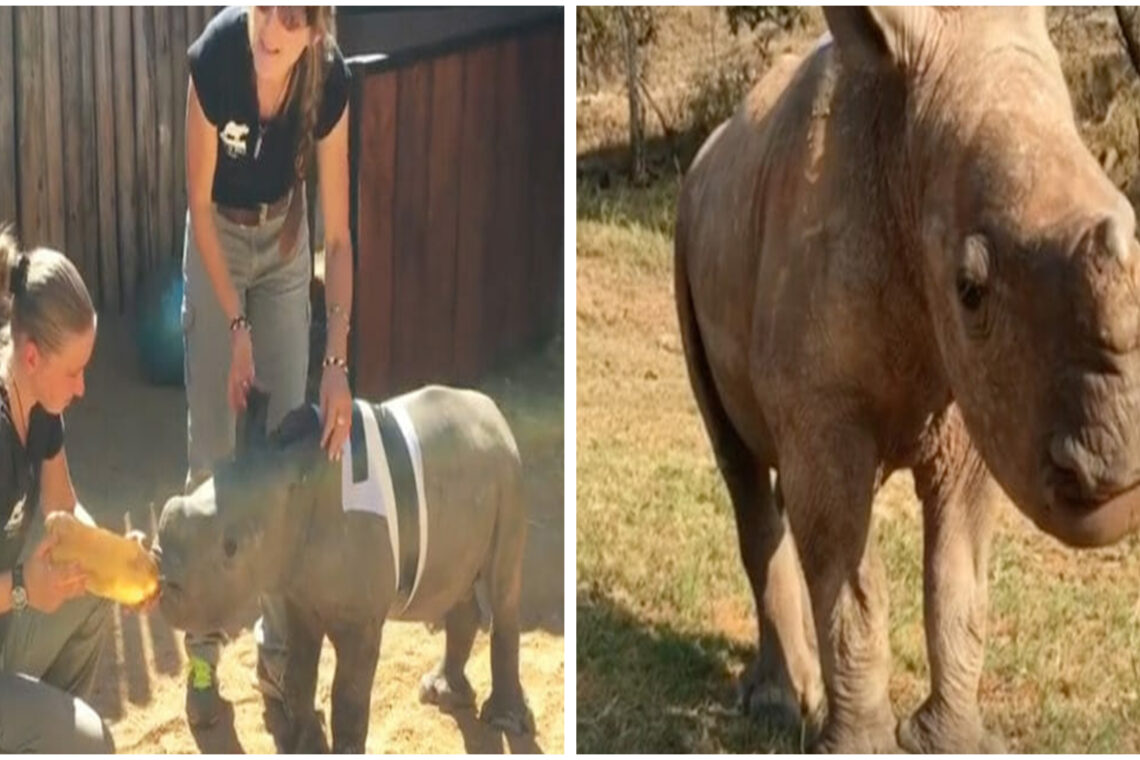
The ongoing battle against poaching continues to escalate, highlighting a painful and distressing reality for many species on the brink of extinction. One of the most alarming examples of this plight can be seen in the tragic fate of African rhinos, which are frequently targeted for their horns. These horns are sought after for their perceived value in the black market, driving these magnificent creatures closer to annihilation.
A recent incident underscores the heart-wrenching consequences of this illegal trade. In a harrowing encounter, wildlife rescuers stumbled upon a mother rhino who had been brutally killed by poachers. In the aftermath of this senseless act, her young calf remained close to her, paralyzed by confusion and grief. When rescuers arrived at the scene, they were relieved to discover that the baby rhino was still alive. While there was no hope for the mother, they took the calf under their wing, determined to save its life.
Petronel Niewouldt, a member of the Care for Wild team, described the instinctual behavior of the young rhino. “It was instinctive for him to try and stay close to his mother to protect her,” she explained, lamenting the cruelty displayed by the poachers. “They acted without a shred of sympathy, intent on completing their vile act as quickly as possible, regardless of the consequences for the innocent calf.”

Once in the hands of the rescue team, the calf, named Arthur, was transported to the Care for Wild Rhino Sanctuary, which holds the distinction of being the largest rhino sanctuary and orphanage in the world. Upon arrival, the baby rhino bore visible signs of trauma: a deep wound on his back from a machete, and one of his toenails had been cruelly severed down to the quick. The calf was understandably frightened, grappling with the loss of his mother and the trauma of the recent events.
To begin his healing process, Arthur was sedated, allowing veterinarians to perform necessary medical procedures. A skilled plastic surgeon was called in to treat the wounds, with careful attention given to minimizing any scarring. This crucial intervention marked the first step toward Arthur’s recovery, but the emotional scars from his ordeal would linger much longer.
After a period of intensive care, the rescuers reported promising progress. Arthur was responding well to treatment, but he still exhibited signs of distress, often calling out for his mother. The team members found this particularly poignant, as it served as a constant reminder of the bond that had been violently severed. “He still calls for his mother,” Niewouldt noted. “It is a heart-wrenching sound that no calf should ever have to make. The impact of her death will haunt him long after his physical wounds have healed.”
In their natural environment, a rhino calf typically stays with its mother for up to three and a half years. During this critical period, the mother imparts essential knowledge and skills needed for survival. She teaches her young how to forage for food, identify safe spaces, and navigate social dynamics with other rhinos. The absence of this maternal guidance poses a significant threat to Arthur’s future. Without the teachings of his mother, there is no one to ensure that he develops into a capable adult rhino.
The caregivers at the sanctuary expressed their deep concern for Arthur’s emotional well-being. They emphasized the importance of maternal influence in a rhino’s early life and lamented the gap left by his mother’s absence. “A mother rhino plays a pivotal role in teaching her calf everything they need to know for survival,” they explained. “Who will guide Arthur now that his mother is gone?”
Fortunately, there have been positive updates regarding Arthur’s progress. He and another young rhino, named Summer, have recently been moved to a larger and more enriching environment within the sanctuary. This new “apartment” offers them a spacious night pen and a vast backyard to explore and play. The sanctuary team has reported that Arthur is thriving in this new setting, displaying an eagerness to run and engage with his surroundings.

Moreover, it has been confirmed that all of Arthur’s injuries have healed completely. His remarkable recovery is a testament to the dedication and hard work of the sanctuary staff. They are overjoyed to see Arthur gaining weight and growing stronger by the day. The staff’s commitment to his rehabilitation and the outpouring of support from the public have played crucial roles in Arthur’s journey toward recovery.
The ongoing crisis of poaching demands immediate attention and action. While regulations and enforcement efforts have tightened in recent years, the fight against this devastating practice must intensify. The tragic story of Arthur and countless other animals illustrates the dire consequences of human greed and the urgent need to protect vulnerable species from those who act without regard for life. Until a comprehensive and effective solution is established, we cannot expect to safeguard innocent creatures like Arthur from the horrors of poaching.
In a world where so many species face the threat of extinction, it is imperative that we rally together to raise awareness and take action against this grave injustice. Advocating for stricter laws, supporting wildlife conservation efforts, and promoting ethical practices can contribute to creating a future where animals like Arthur can thrive in their natural habitats, free from the shadow of poaching. By working collaboratively, we can strive to ensure that the heartbreaking stories of loss are replaced with narratives of hope, recovery, and preservation for generations to come.